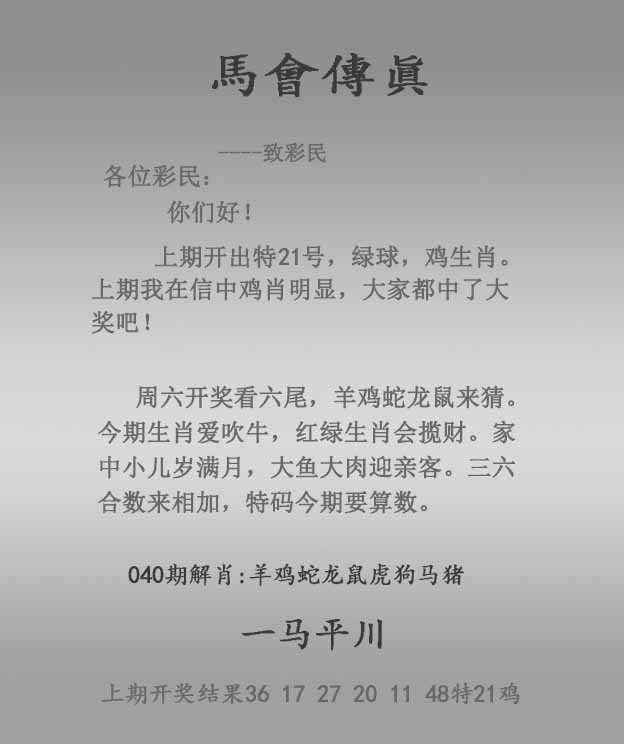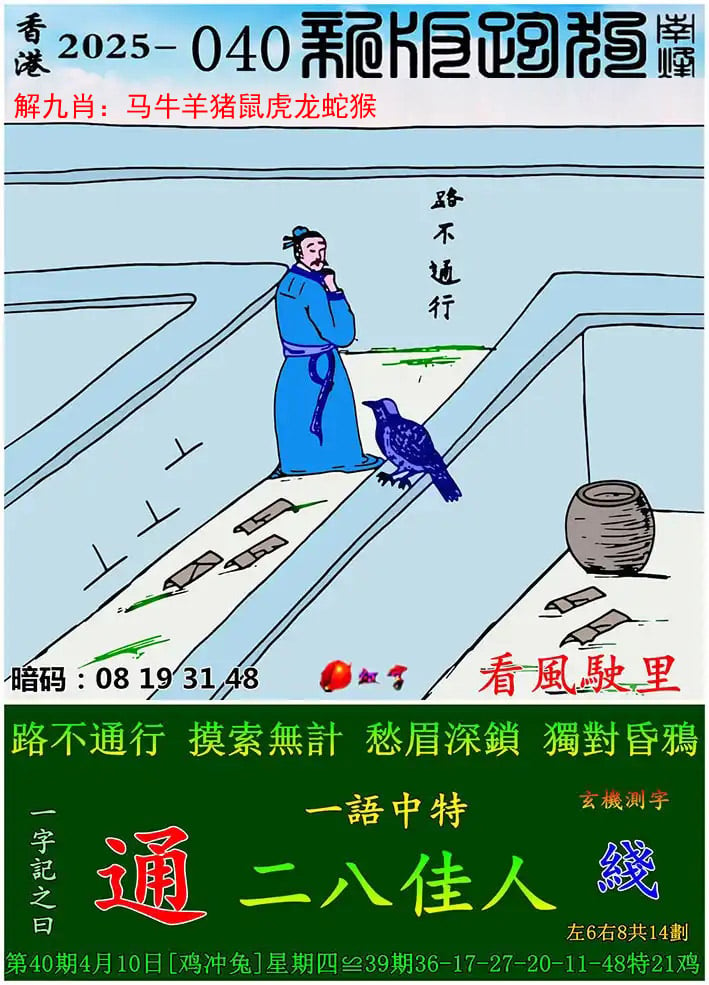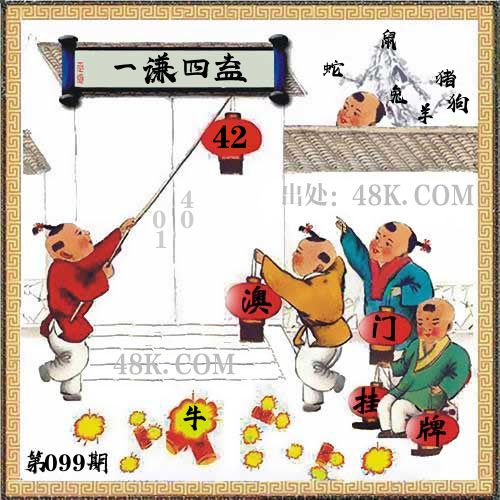
|
099期 | |
|---|---|---|
| 挂牌 | 42 | |
| 火烧 | 牛 | |
| 横批 | 一谦四益 | |
| 门数 | 01,04 | |
| 六肖 | 鼠蛇猪兔狗羊 | |
- 099期:【贴身侍从】必中双波 已公开
- 099期:【过路友人】一码中特 已公开
- 099期:【熬出头儿】绝杀两肖 已公开
- 099期:【匆匆一见】稳杀5码 已公开
- 099期:【风尘满身】绝杀①尾 已公开
- 099期:【秋冬冗长】禁二合数 已公开
- 099期:【三分酒意】绝杀一头 已公开
- 099期:【最爱自己】必出24码 已公开
- 099期:【猫三狗四】绝杀一段 已公开
- 099期:【白衫学长】绝杀一肖 已公开
- 099期:【满目河山】双波中 已公开
- 099期:【寥若星辰】特码3行 已公开
- 099期:【凡间来客】七尾中特 已公开
- 099期:【川岛出逃】双波中特 已公开
- 099期:【一吻成瘾】实力五肖 已公开
- 099期:【初心依旧】绝杀四肖 已公开
- 099期:【真知灼见】7肖中特 已公开
- 099期:【四虎归山】特码单双 已公开
- 099期:【夜晚归客】八肖选 已公开
- 099期:【夏日奇遇】稳杀二尾 已公开
- 099期:【感慨人生】平特一肖 已公开
- 099期:【回忆往事】男女中特 已公开
- 099期:【疯狂一夜】单双中特 已公开
- 099期:【道士出山】绝杀二肖 已公开
- 099期:【相逢一笑】六肖中特 已公开
- 099期:【两只老虎】绝杀半波 已公开
- 099期:【无地自容】绝杀三肖 已公开
- 099期:【凉亭相遇】六肖中 已公开
- 099期:【我本闲凉】稳杀12码 已公开
- 099期:【兴趣部落】必中波色 已公开
| 099期:澳门天天好彩AA级公开; 还等啥大胆砸 |
|---|
| 099期:精选九肖:鼠鸡牛蛇虎龙羊猪狗 |
| 099期:精选六肖:鼠鸡牛蛇虎龙 |
| 099期:精选四肖:鼠鸡牛蛇 |
| 099期:精选三肖:鼠鸡牛 |
| 099期:精选二肖:鼠鸡 |
| 099期:精选一肖:鼠 |
| 099期:精选尾数:0.1.5.2.9 |
| 099期:家禽野兽:野兽 |
| 099期:平特一肖:双数 |
| 099期:精选十码:06.18.09.29.25.28.26.35.19.08 |
| 099期:精选五码:06.18.09.29.25 |
| 099期:精选三码:06.18.09 |
| 六合活动进行中:站长担保 点击投注 |
| 099期:精选一码:重拳出击-06-信心十足 |
| 098期:澳门天天好彩AA级公开; 还等啥大胆砸 |
|---|
| 098期:精选九肖:虎鼠蛇猴龙鸡猪羊兔 |
| 098期:家禽野兽:野兽 |
| 六合活动进行中:站长担保 点击投注 |
| 097期:澳门天天好彩AA级公开; 还等啥大胆砸 |
|---|
| 097期:精选九肖:猪鸡狗龙兔羊牛鼠蛇 |
| 097期:精选六肖:猪鸡狗龙兔羊 |
| 097期:精选四肖:猪鸡狗龙 |
| 097期:精选三肖:猪鸡狗 |
| 097期:精选二肖:猪鸡 |
| 097期:精选一肖:猪 |
| 097期:精选尾数:4.5.0.1.2 |
| 097期:家禽野兽:家禽 |
| 097期:平特一肖:单数 |
| 097期:精选十码:19.31.09.08.26.27.35.29.18.37 |
| 097期:精选五码:19.31.09.08.26 |
| 097期:精选三码:19.31.09 |
| 六合活动进行中:站长担保 点击投注 |
- 澳门四不像精解
- 香港四不像精解

099期今期鼠羊牛出特,二七不凑十回头开?00准
①杀马鸡虎猪(09.21.33.45.04.16.28.40.07.19.31.43)
②图解特肖鼠羊牛马狗
③合双+大数
更多资料尽在新澳门开奖结果2025开奖记录
097期今期蛇马鼠出特,四二三七是何处开猪31准
①杀虎猴狗(04.16.28.40.10.22.34.46.08.20.32.44)
②图解特肖蛇马鼠牛猪
③合单+小数
更多资料尽在新澳门开奖结果2025开奖记录
095期今期兔狗马出特,雪高三尺云上天开狗20准
①杀羊鸡鼠(11.23.35.47.09.21.33.45.06.18.30.42)
②图解特肖兔狗马虎猴
③合单+大数
更多资料尽在新澳门开奖结果2025开奖记录
- 澳门平特心水
- 香港平特心水
099期平牛→牛鼠(2连)→牛鼠蛇(3连)
098期平猪→猪虎(2连)→猪虎羊(3连)
- 澳门传真
- 香港传真

澳门传真099期
解:这几句似乎是彩票玄机诗,通过生肖和数字的隐喻来暗示开奖号码或运势。解释:二七开:可能指数字 2、7 或生肖 虎(3)、马(7)。田叶荷花莲藕香:象征 蛇(田)、兔(叶)、鸡(荷花)。二通三八财运来:可能指数字 2、3、8 或生肖 牛(2)、兔(4)、羊(8)。公鸡来:明确点出生肖 鸡。生肖表达:牛(2):财运稳固,虎(3):二七开局,兔(4):桃花旺盛,蛇(6):田叶藏机,马(7):二七助力,羊(8):财运亨通,鸡(10):特码关键
七肖:牛虎兔蛇马羊鸡
五肖:牛虎兔蛇马
三肖:牛虎兔
主特:05.17.16.28.15.27.37.36.23.09
更多资料尽在新澳门开奖结果2025开奖记录
澳门传真098期
解:这几句暗藏生肖玄机,结合数字与意象解析如下:四五开:4(兔)、5(龙),二者相逢,象征机遇与变化。三七做大戏:3(虎)、7(马),虎马相争,暗喻激烈竞争。一三尾:1(鼠)、3(虎),鼠虎相随,代表首尾呼应,成败关键。十八罗汉镇邪魔:18拆解为1(鼠)+8(羊),鼠羊组合,寓意以智克邪。鼠头蛇尾:鼠(机敏)、蛇(隐忍),警示有始无终之象。三九出一出二:3(虎)、9(猴),虎猴相斗,终见分晓。七生肖:兔、龙、虎、马、鼠、羊、猴,暗合数字博弈与运势起伏,既有竞争锋芒,亦含智谋制胜
七肖:兔龙虎马鼠羊猴
五肖:兔龙虎马鼠
三肖:兔龙虎
主特:15.27.14.26.16.28.36.18.35.34
更多资料尽在新澳门开奖结果2025开奖记录
澳门传真096期
解:这首谜语暗藏生肖玄机:二四开指兔(第4位生肖,拆半为二);田字出头是鼠(田上加撇为鼠);六合指蛇(六合生肖);红波喻马(红鬃烈马);叛徒大将为狗(犬字含大);神偷指猴(机灵善窃);好吃懒做是猪。七生肖中,兔鼠蛇马狗猴猪各显特性,唯有勤勉者方能顺风顺水,懒散者终将失手
七肖:兔鼠蛇马狗猴猪
五肖:兔鼠蛇马狗
三肖:兔鼠蛇
主特:15.27.06.18.25.37.36.08.34.19
更多资料尽在新澳门开奖结果2025开奖记录
- 澳门五肖十码
- 香港五肖十码
099期推荐⑤肖:虎马猴龙鼠
099期推荐③肖:虎马猴
099期推荐⑩码:16.28.24.36.34.46.14.26.06.18
099期推荐⑤码:16.28.24.36.34
更多资料尽在新澳门开奖结果2025开奖记录
098期推荐⑤肖:龙牛虎兔蛇
098期推荐③肖:龙牛虎
098期推荐⑩码:14.26.17.29.16.28.15.27.25.37
098期推荐⑤码:14.26.17.29.16
更多资料尽在新澳门开奖结果2025开奖记录
096期推荐⑤肖:鼠猴蛇兔虎
096期推荐③肖:鼠猴蛇
096期推荐⑩码:06.18.34.46.25.37.15.27.16.28
096期推荐⑤码:06.18.34.46.25
更多资料尽在新澳门开奖结果2025开奖记录
095期推荐⑤肖:马鼠龙狗牛
095期推荐③肖:马鼠龙
095期推荐⑩码:36.48.06.18.14.26.08.20.17.29
095期推荐⑤码:36.48.06.18.14
更多资料尽在新澳门开奖结果2025开奖记录
- 澳门红字肖
- 香港红字肖
099期红字暗码【草长莺飞】【01 18 39 48】
解析:形容江南暮春的景色。出自南朝梁 丘迟《与陈伯之书》。解羊狗鼠蛇龙猪
解取特肖:羊狗鼠蛇龙猪
解取五肖:羊狗鼠蛇龙
解取四肖:羊狗鼠蛇
098期红字暗码【火树银花】【03 26 31 42】
解析:形容张灯结彩或大放焰火的灿烂夜景。比喻灿烂的灯火或焰火。解狗虎鸡猴兔牛
解取特肖:狗虎鸡猴兔牛
解取五肖:狗虎鸡猴兔
解取四肖:狗虎鸡猴
- 澳门平五不中
- 香港平五不中
099期【47.36.44.45.41】?
098期【01.19.34.02.07】准
097期【22.37.11.03.14】准
- 澳门传真20码
- 香港传真20码
099期澳门内幕传真20码开?00
特码玄机:241 275(猴34)13+06= ?
五光十色艳红天,荷花出水喜相逢
提供20码:
12 16 21 08 47 06 07 17 11 29
49 10 15 13 25 22 19 24 43 35
097期澳门内幕传真20码开猪31
特码玄机:302 267(羊23)18+13= ?
黑甜水美竭羲皇,凶人夜半发丘陇
提供20码:
16 05 17 40 43 35 32 30 15 22
26 23 18 06 10 01 49 25 31 33
096期澳门内幕传真20码开猴34
特码玄机:246 124(虎16)22+06= ?
春风野火烧大地,绿叶化土更护花
提供20码:
34 03 25 43 47 39 02 26 38 40
18 41 08 01 11 07 13 45 42 35
095期澳门内幕传真20码开狗20
特码玄机:302 179(马24)25+14= ?
冤家路窄要单挑,如日中天一定吉
提供20码:
15 39 19 20 01 42 49 08 31 47
04 22 14 05 17 11 07 12 38 48
- 澳门精准单双
- 香港精准单双
099期精准单双〖单数〗开:?00准
098期精准单双〖单数〗开:兔03准
097期精准单双〖单数〗开:猪31准
096期精准单双〖双数〗开:猴34准
095期精准单双〖双数〗开:狗20准
093期精准单双〖双数〗开:猴10准
091期精准单双〖双数〗开:虎40准
089期精准单双〖双数〗开:龙14准
088期精准单双〖单数〗开:兔15准
087期精准单双〖单数〗开:兔15准
085期精准单双〖单数〗开:羊35准
- 澳门玄机诗
- 香港玄机诗
099期【澳彩玄机诗】
虎斗兔搅局,两边有鸡会:开?00
解:
098期【澳彩玄机诗】
水美竭羲皇,夜半发丘陇:开兔03
解:特码开兔03
097期【澳彩玄机诗】
同单一起走,前方记住先:开猪31
解:特码开猪31
096期【澳彩玄机诗】
昨夜过渠黎,已在金山北:开猴34
解:特码开猴34
095期【澳彩玄机诗】
雪月过十六,宰羊挂红灯:开狗20
解:特码开狗20
- 澳门跑狗图
- 香港跑狗图
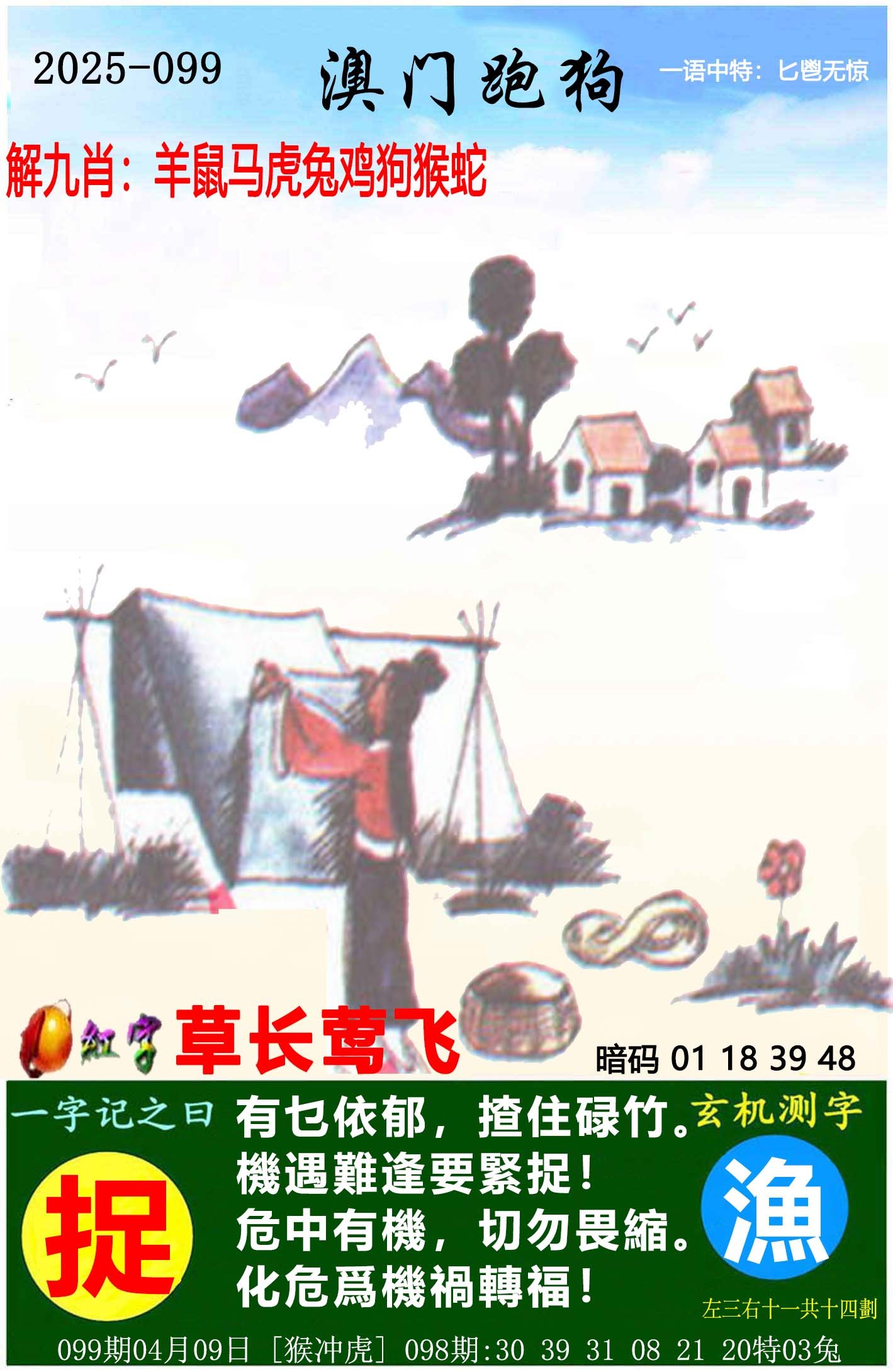
099期跑狗一字記之曰:【捉】
有包依郁,揸住碌竹。機遇難逢要緊捉
危中有機,切勿畏縮。化危爲機禍轉福
解:这段文字强调危机即转机,鼓励把握机遇、化险为夷。有包依郁,揸住碌竹比喻做好准备、稳握机会;危中有机则提醒在困境中寻找突破口。生肖演绎:鼠:危中嗅机,智破困局,牛:稳执碌竹,厚积薄发,虎:勇闯险境,扭转乾坤,兔:机敏脱困,借势跃升,龙:风云际会,化厄为祥,祸退福临注:碌竹在粤语中可指棍棒/工具,此处引申为把握关键依仗。各生肖特性与危机应对方式巧妙呼应,体现转祸为福的智慧
五肖:鼠牛虎兔龙
四肖:鼠牛虎兔
三肖:鼠牛虎
二肖:鼠牛
一肖:鼠
098期跑狗一字記之曰:【徽】
甲和上乙,齊齊當兵。指使懵丙去摇丁
戊己出庚,辛苦的命。王月癸日來應徵
解:这四句诗暗含天干地支与生肖的对应关系,结合五行和生肖特性解析如下:甲(虎)、乙(兔):甲乙属木,齊齊當兵象征虎兔同行,勇猛与机敏结合。丙(蛇)、丁(马):懵丙摇丁指蛇马相随,蛇智谋深,马行动快,但需谨慎行事。戊(龙)、己(羊)、庚(猴):戊己出庚代表龙羊合力,猴来收尾,寓意历经艰辛终得成果。壬(猪)、癸(鼠):王(壬)月癸日指猪鼠应征,猪主福气,鼠主机灵,象征贵人相助。生肖:虎、兔、蛇、马、龙,暗合天干五行,既有协作奋进,亦含命运起伏,需智勇兼备方能成事
五肖:虎兔蛇马龙
四肖:虎兔蛇马
三肖:虎兔蛇
二肖:虎兔
一肖:虎
- 澳门绝杀三只
- 香港绝杀三只
099期绝杀三只【猪蛇马】开?00准
097期绝杀三只【蛇鸡猴】开猪31准
096期绝杀三只【蛇猪鸡】开猴34准
095期绝杀三只【蛇兔猴】开狗20准
094期绝杀三只【羊马狗】开鸡33准
093期绝杀三只【鼠虎鸡】开猴10准
091期绝杀三只【牛鸡猴】开虎40准
089期绝杀三只【蛇羊马】开龙14准
088期绝杀三只【狗猴蛇】开兔15准
087期绝杀三只【狗猴蛇】开兔15准
086期绝杀三只【猪牛兔】开鼠30准
085期绝杀三只【鸡虎马】开羊35准
084期绝杀三只【鼠猴马】开狗20准
083期绝杀三只【猪龙羊】开虎28准
081期绝杀三只【狗虎猪】开龙38准
080期绝杀三只【猴兔鼠】开马24准
079期绝杀三只【猪鸡马】开猴10准
078期绝杀三只【鸡羊龙】开虎28准
077期绝杀三只【羊蛇虎】开猴22准
076期绝杀三只【鸡鼠虎】开兔39准
075期绝杀三只【兔猪狗】开鸡09准
074期绝杀三只【鸡鼠马】开羊35准
073期绝杀三只【牛龙蛇】开兔03准
072期绝杀三只【羊牛兔】开虎40准
071期绝杀三只【羊猴鼠】开蛇49准
070期绝杀三只【猴虎兔】开猪43准
069期绝杀三只【猴羊鸡】开牛29准
068期绝杀三只【虎蛇羊】开狗44准
067期绝杀三只【牛龙马】开狗44准
066期绝杀三只【虎蛇鸡】开马12准
065期绝杀三只【牛猪兔】开马48准
064期绝杀三只【羊虎兔】开猪31准
- 澳门藏宝图
- 香港藏宝图
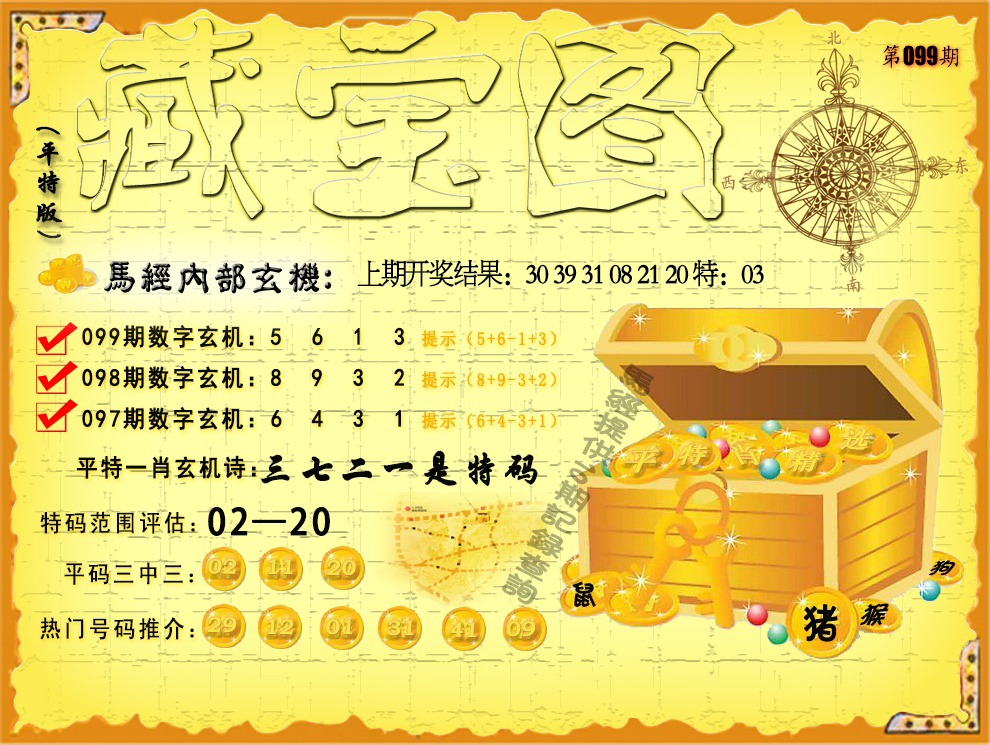
099期平特藏宝图玄机
【三七二一是特码】
解:三七二一是特码,平特蛇猴
特码范围评估:02-20
推荐平码:29.12.01.31.41.09
开奖结果:00-00-00-00-00-00T00
097期平特藏宝图玄机
【上期夫人找秀才】
解:上期夫人找秀才,平特马羊
特码范围评估:02-18
推荐平码:29.12.01.31.41.09
开奖结果:01-32-24-23-04-02T31
096期平特藏宝图玄机
【汉前将军多说法】
解:汉前将军多说法,平特马虎
特码范围评估:01-20
推荐平码:28.11.02.30.40.08
开奖结果:42-46-25-05-40-22T34

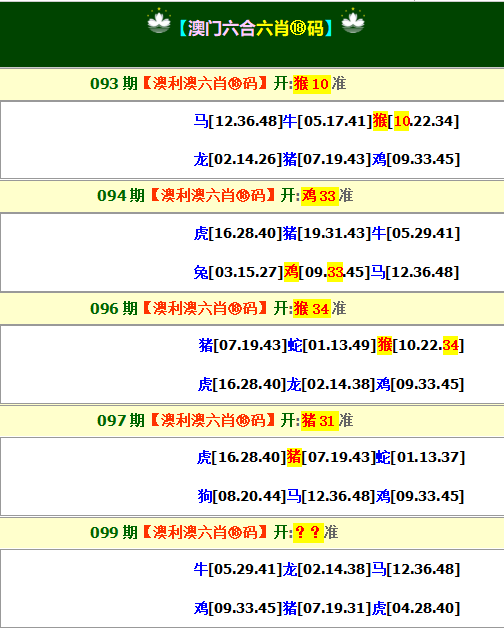

099期小小分析:这段文字以两只野兔争斗的画面隐喻激烈竞争或隐藏矛盾,暗示本期玄机需从对抗与因果中解读。动手动脚象征冲突,深仇大恨则暗藏故事性,可能对应生肖间的相冲或数字组合。生肖演绎:兔(主角):双兔相争,暗藏玄机,虎:压制野性,象征强势干预,蛇:智慧潜伏,化解仇怨,马:草原霸主,旁观定局,猴:挑拨离间,幕后推手,狗:忠诚调解,平息纷争,鸡:黎明啼鸣,揭晓真相。注:以兔为核心,其他生肖或激化矛盾(虎、猴)、或调和冲突(蛇、狗),呼应图像中的动态张力与未言之秘
综合特肖:兔虎蛇马猴狗鸡
主攻四肖:兔虎蛇马
主攻特码:15.27.16.28.25.37.36.34.08.09
098期小小分析:这段文字通过动物意象暗藏生肖玄机,可对应以下7个生肖:橘猫(虎)——猫科动物,象征威严与专注,对应生肖虎。小黑狗(狗)——忠诚守护,代表生肖狗。鹦鹉(鸡)——鸟类对应生肖鸡,寓意警觉与灵性。全神贯注(蛇)——蛇性专注,紧盯目标不放松。排排站好(兔)——兔子机敏有序,善于观察。生怕错过(鼠)——鼠目精明,警惕性高,生怕遗漏细节。玄机(猴)——猴性聪慧,擅解谜题,暗示本期暗藏机巧。七生肖:虎、狗、鸡、蛇、兔、鼠、猴,共同构成一幅专注探秘的画面,暗喻观察力与智慧的结合,等待揭晓谜底
综合特肖:虎狗鸡蛇兔鼠猴
主攻四肖:虎狗鸡蛇
主攻特码:16.28.08.20.09.21.25.15.18.34
096期小小分析:雪原上,寅虎(猫)与戌狗(狗)拼命奔逃,身后丑牛(庞然大物)的巨蹄震裂冰层!巳蛇(玄机)在雪下蜿蜒,暗示危险来自地底;未羊(幻象)的雾影迷惑方向,申猴(智慧)却叼着卯兔(钥匙)窜过树梢——唯有子鼠(机敏)钻入冰缝,窥见真相:所谓“怪物”竟是辰龙(冰川苏醒)的投影!图片暗藏生肖轮回,七兽聚首则雪崩平息
综合特肖:虎狗牛蛇羊猴兔
主攻四肖:虎狗牛蛇
主攻特码:16.28.32.44.17.29.25.35.34.15
094期小小分析:这幅双鼠谋略图,暗藏7个关键生肖的联动玄机——鼠(子)×2:望远镜鼠(侦查先锋)笔记鼠(情报分析)▶ 体现子水双生,智谋叠加;猴(申):幕后军师角色(申金生水助鼠)▶ 望远镜象征猴的远见;龙(辰):侦查目标(辰为水库,暗喻远方大计)蛇(巳):情报传递者(巳火融金,蛇形暗线)鸡(酉):计划执行者(酉金为钟,精准行动)马(午):突围关键(午火冲子,时机突破)。阴谋阳谋解码:双鼠(情报)→ 猴(策划)→ 蛇(暗网)→ 鸡马(行动)→ 龙(终极目标)。排除牛虎兔羊狗猪等生肖,因缺乏间谍行动所需的**诡变(猴)与迅捷(马)**特质。图中望远镜暗示见龙在田,笔记簿暗藏申子辰三合水局——这或是生肖版的特工围猎大戏
综合特肖:鼠猴龙蛇鸡马
主攻四肖:鼠猴龙蛇
主攻特码:06.18.34.46.14.26.25.37.09.36
092期小小分析:这段谜语描述小猪被小狗追逐的奇特场景,暗藏生肖玄机。用7个生肖解读:猪——主角只穿衣服的小猪,象征财富(猪招财)或某种伪装。狗——锲而不舍追逐,代表忠诚或执着,也可能暗指狗猪相冲(戌亥相邻)。猴——穿衣奔跑似猴性机灵,善伪装(如孙悟空变化)。蛇——小猪跑到海边,蛇象征隐秘(水属阴),或暗示蛇猪相合(巳亥冲)。鼠——小狗为何狂追?鼠(子)与猪(亥)暗合水局,可能暗藏数字玄机。马——到处奔跑似马驰骋,但被追暗示马失前蹄。兔——小猪回头一望,兔机敏胆小,或暗藏卯亥未三合局。玄机:可能指向**猪狗冲(亥戌)**或隐藏水边相关生肖(鼠、蛇)
综合特肖:猪狗猴蛇鼠马兔
主攻四肖:猪狗猴蛇
主攻特码:19.31.08.20.34.46.37.18.36.15
091期小小分析:这段描述暗喻强弱对抗、生死博弈的玄机——山猫代表强势追击者(猎手),而野鸡象征弱势求存者(猎物),求饶无果暗示命运已定。图片玄机可能隐藏生肖相克、时机或方位的线索。【生肖喻】虎(山猫的凶悍)→ 2. 鸡(野鸡,本期焦点)→ 3. 蛇(暗中埋伏,如猫狩猎)→ 4. 兔(弱势挣扎,如鸡求饶)→ 5. 狗(追逐拦截,辅助猎杀)→ 6. 鼠(机敏逃脱失败)→ 7. 马(快速奔逃却难甩脱)。寓意:弱肉强食是自然法则,但若如龙(智慧)或猴(灵活)或能破局
综合特肖:虎鸡蛇兔狗虎马
主攻四肖:虎鸡蛇兔
主攻特码:16.28.09.21.13.25.27.08.28.36
088期小小分析:这段文字通过露营故事展现了才高八斗的智慧与守护之情,用生肖诠释如下:虎(男子守护如猛虎,威震荒野)兔(女友持棍自卫,柔中带刚似玉兔)狗(忠诚守夜,暗喻男子营外警戒)猴(才高八斗显急智,如猴灵活应变)蛇(棍如蛇形,暗藏防卫机锋)马(露营奔放自由,呼应野外冒险精神)猪(反衬安逸者,若无人守护则如猪般 vulnerable)龙鼠羊鸡牛未选——龙过尊不涉凡护,鼠羊怯弱,鸡牛无野营特质。核心以虎狗显守护,兔猴喻智勇,蛇马应情境,展现代版才子护佳人之趣
综合特肖:虎兔狗猴蛇马猪
主攻四肖:虎兔狗猴
主攻特码:16.28.27.39.08.20.34.37.24.19
087期小小分析:这段对话以幽默方式化解职场尴尬,用龙(画龙画虎开场,象征老板威严形象)牛(小勒打瞌睡像耕牛疲惫,暗喻职场辛劳)猴(老板急中生智的抓狂idea,体现猴的机灵)狗(小勒忠诚配合演出,如狗般顺从)鼠(万有引力联想到牛顿被苹果砸,鼠擅偷啃水果)蛇(下雨没砸到暗喻蛇般灵活躲过危机)兔(下次再砸展现兔子的侥幸心理)生肖智慧:职场如丛林,用龙威镇场、猴智解围、牛勤兔巧,方能蛇形走位化解危机。(注:生肖关联侧重情境隐喻而非字面直解)
综合特肖:龙牛猴狗鼠蛇兔
主攻四肖:龙牛猴狗
主攻特码:14.26.05.17.34.46.08.18.25.27
086期小小分析:这段文字以幽默口吻描述“怕痒”引发的尴尬场景——老中医因患者夸张反应被迫放弃治疗,强调“名誉”比赚钱更重要,充满生活喜剧色彩。生肖演绎(选取与情境契合的生肖特质):鼠:机灵滑头,反应夸张(对应“油嘴滑舌”)兔:敏感怕痒,一惊一乍(直接呼应“嗷一嗓子”)猴:戏精附体,演技浮夸(推动喜剧效果)鸡:嗓门洪亮,叫声突兀(模拟“推一下叫一声”)狗:忠诚守誉,中医大叔的坚持(“要名誉的人”)猪:憨态躺平,任人摆布(趴床任推拿的姿势)马:尥蹶子式反应(暗喻突然弹跳的怕痒者)缺(牛虎龙蛇羊):牛沉稳、虎凶猛、龙高傲、蛇隐忍、羊温顺,皆不符“滑稽逃诊”主题。核心生肖兔、猴、鸡,精准捕捉“痒觉敏感—夸张反应—名誉危机”的搞笑链条
综合特肖:鼠兔猴鸡狗猪马
主攻四肖:鼠兔猴鸡
主攻特码:06.18.15.27.34.46.09.08.19.36
084期小小分析:这段药店趣事通过谐音梗(泻闲/谢贤、泻停封/谢霆锋、泻停停/谢婷婷)制造笑料,展现小哥用机智化解顾客不适的暖心服务。【7生肖演绎】鼠(机灵)——小哥俏皮玩谐音梗牛(踏实)——认真推荐泻立停真药兔(敏捷)——迅速接话化解尴尬马(奔放)——脱口而出的明星谐音猴(诙谐)——用玩笑缓解顾客疼痛鸡(准时)——清晨疲惫进药店的顾客狗(忠诚)——药店小哥的职业精神
综合特肖:鼠牛兔马猴鸡狗
主攻四肖:鼠牛兔马
主攻特码:06.18.05.17.15.27.36.34.09.08
083期小小分析:这段文字描述了一群人在露营时迷路的幽默场景。“牛鬼蛇神”象征一群奇怪或有趣的人,“露营迷路”指在山中迷失方向,“走了很久走不出去”表现无奈。“拿出手机,报警”试图求救,但“喂,是110吗?”后,对方竟说“那就睡会儿吧”,随后挂断电话,充满荒诞感。用生肖表达:牛(牛鬼蛇神)、虎(山中困境)、兔(胆小)、蛇(牛鬼蛇神)、马(奔波)、猴(调皮)、狗(忠诚尝试求救)
综合特肖:牛虎兔蛇马猴狗
主攻四肖:牛虎兔蛇
主攻特码:17.29.16.28.15.27.37.36.46.08
082期小小分析:这段幽默小故事通过尴尬的误会,揭示了人际沟通中的微妙与荒诞:女生委婉提醒男友「鼻边有米粒」,实则暗示鼻屎需擦拭,但男友误以为是食物直接舔食,闹出笑话。用生肖特质可映射其中人性:鼠:机敏却过度迂回(女生用隐喻提醒)。牛:固执误解(男友坚持「米粒=可食用」)。虎:冲动直率(舔食动作毫无犹豫)。兔:温和避冲突(不敢直言「鼻屎」)。蛇:精明反被误(暗示策略失败)。猴:戏谑化解尴尬(事件自带喜剧效果)。狗:忠诚但笨拙(无条件信任对方话语)。深意:生肖特质暗合人性弱点——沟通中的「信息错位」常源自过度迂回(鼠/兔)与盲目直率(牛/虎),而幽默(猴)恰是化解尴尬的良药
综合特肖:鼠牛虎兔蛇猴狗
主攻四肖:鼠牛虎兔
主攻特码:30.42.29.41.16.28.27.25.34.08
081期小小分析:这个故事充满了戏剧性与幽默感:主人公为了接近心仪的看店女孩(水储风絮),每天买大量饮料,但最终却与垃圾回收站老板的女儿走到了一起,展现了缘分与现实的奇妙交织。用生肖表达:鼠:机灵聪明,善于制造机会。牛:憨厚执着,每天坚持买水。虎:勇敢主动,敢于追求心仪之人。兔:温柔可爱,象征看店女孩的形象。龙:胸怀大志,但缘分却出人意料。蛇:灵活应变,最终接受现实。猪:随缘知足,与垃圾站老板女儿结缘。这些生肖共同体现了故事中的幽默与人生无常的哲理
综合特肖:鼠牛虎兔龙蛇猪
主攻四肖:鼠牛虎兔
主攻特码:06.18.17.29.16.28.27.14.37.19
080期小小分析:这段文字描述了学校附近的刀削面馆和老板儿子的趣事,展现了孩子的天真与听话。用十二生肖中的7个来表达:鼠(机灵的孩子)、牛(勤恳的老板)、兔(乖巧听话)、蛇(面馆的隐秘角落)、马(面馆的热闹氛围)、羊(孩子的纯真)、狗(忠诚于妈妈的话)。这些生肖象征了面馆的日常场景,孩子的懂事与老板的辛勤,充满了生活气息
综合特肖:鼠牛兔蛇马羊狗
主攻四肖:鼠牛兔蛇
主攻特码:06.18.05.17.15.27.25.36.34.08
- 澳门四不像
- 澳门传真图
- 澳门跑马图
- 新挂牌彩图
- 另版跑狗图
- 老版跑狗图
- 澳门玄机图
- 玄机妙语图
- 六麒麟透码
- 平特一肖图
- 一字解特码
- 新特码诗句
- 四不像玄机
- 小黄人幽默
- 新生活幽默
- 30码中特图
- 澳门抓码王
- 澳门天线宝
- 澳门一样发
- 曾道人暗语
- 鱼跃龙门报
- 无敌猪哥报
- 特码快递报
- 一句真言图
- 新图库禁肖
- 三怪禁肖图
- 正版通天报
- 三八婆密报
- 博彩平特报
- 七肖中特报
- 神童透码报
- 内幕特肖B
- 内幕特肖A
- 内部传真报
- 澳门牛头报
- 千手观音图
- 梦儿数码报
- 六合家宝B
- 合家中宝A
- 六合简报图
- 六合英雄报
- 澳话中有意
- 彩霸王六肖
- 马会火烧图
- 狼女侠客图
- 凤姐30码图
- 劲爆龙虎榜
- 管家婆密传
- 澳门大陆仔
- 传真八点料
- 波肖尾门报
- 红姐内幕图
- 白小姐会员
- 白小姐密报
- 澳门大陆报
- 波肖一波中
- 庄家吃码图
- 发财波局报
- 36码中特图
- 澳门男人味
- 澳门蛇蛋图
- 白小姐救世
- 周公玄机报
- 值日生肖图
- 凤凰卜封图
- 腾算策略报
- 看图抓码图
- 神奇八卦图
- 新趣味幽默
- 澳门老人报
- 澳门女财神
- 澳门青龙报
- 财神玄机报
- 内幕传真图
- 每日闲情图
- 澳门女人味
- 澳门签牌图
- 澳六合头条
- 澳门码头诗
- 澳门两肖特
- 澳门猛虎报
- 金钱豹功夫
- 看图解特码
- 今日闲情1
- 开心果先锋
- 今日闲情2
- 济公有真言
- 四组三连肖
- 金多宝传真
- 皇道吉日图
- 澳幽默猜测
- 澳门红虎图
- 澳门七星图
- 功夫早茶图
- 鬼谷子爆肖
- 观音彩码报
- 澳门不夜城
- 挂牌平特报
- 新管家婆图
- 凤凰天机图
- 赌王心水图
- 佛祖禁肖图
- 财神报料图
- 二尾四码图
- 东成西就图
- 12码中特图
- 单双中特图
- 八仙指路图
- 八仙过海图
- 正版射牌图
- 澳门孩童报
- 通天报解码
- 澳门熊出没
- 铁板神算图
- 杀料专区
- 独家资料
- 独家九肖
- 高手九肖
- 澳门六肖
- 澳门三肖
- 云楚官人
- 富奇秦准
- 竹影梅花
- 西门庆料
- 皇帝猛料
- 旺角传真
- 福星金牌
- 官方独家
- 贵宾准料
- 旺角好料
- 发财精料
- 创富好料
- 水果高手
- 澳门中彩
- 澳门来料
- 王中王料
- 六合财神
- 六合皇料
- 葡京赌侠
- 大刀皇料
- 四柱预测
- 东方心经
- 特码玄机
- 小龙人料
- 水果奶奶
- 澳门高手
- 心水资料
- 宝宝高手
- 18点来料
- 澳门好彩
- 刘伯温料
- 官方供料
- 天下精英
- 金明世家
- 澳门官方
- 彩券公司
- 凤凰马经
- 各坛精料
- 特区天顺
- 博发世家
- 高手杀料
- 蓝月亮料
- 十虎权威
- 彩坛至尊
- 传真內幕
- 任我发料
- 澳门赌圣
- 镇坛之宝
- 精料赌圣
- 彩票心水
- 曾氏集团
- 白姐信息
- 曾女士料
- 满堂红网
- 彩票赢家
- 澳门原创
- 黃大仙料
- 原创猛料
- 各坛高手
- 高手猛料
- 外站精料
- 平肖平码
- 澳门彩票
- 马会绝杀
- 金多宝网
- 鬼谷子网
- 管家婆网
- 曾道原创
- 白姐最准
- 赛马会料
零顶商贸有限公司 YOUNGJUNG 成立于2012年,位于山东省青岛市,经营范围一般项目:服装辅料销售;服装服饰批发;鞋帽批发;箱包销售;工艺美术品及礼仪用品销售。。(ICP备案号)
友情链接:百度
网站的广告和外链,所有内容均转载自互联网,内容与本站无关!
本站内容谨供娱乐参考,不可用于不法活动,严禁转载和盗链等!并且防止相关欺骗性内容。
Copyright ©2012 - 2024 零顶商贸有限公司 YOUNGJUNG, All Rights Reserved











